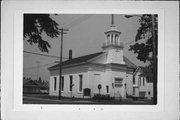Property Record
100 E JEFFERSON ST
Architecture and History Inventory
| Historic Name: | BURLINGTON FREE CHURCH |
|---|---|
| Other Name: | CHURCH OF THE NAZARENE |
| Contributing: | Yes |
| Reference Number: | 10628 |
| Location (Address): | 100 E JEFFERSON ST |
|---|---|
| County: | Racine |
| City: | Burlington |
| Township/Village: | |
| Unincorporated Community: | |
| Town: | |
| Range: | |
| Direction: | |
| Section: | |
| Quarter Section: | |
| Quarter/Quarter Section: |
| Year Built: | 1852 |
|---|---|
| Additions: | |
| Survey Date: | 19752011 |
| Historic Use: | house of worship |
| Architectural Style: | Greek Revival |
| Structural System: | |
| Wall Material: | Fieldstone |
| Architect: | |
| Other Buildings On Site: | |
| Demolished?: | No |
| Demolished Date: |
| National/State Register Listing Name: | Kane Street Historic District |
|---|---|
| National Register Listing Date: | 7/25/2014 |
| State Register Listing Date: | 11/22/2013 |
| National Register Multiple Property Name: |
| Additional Information: | In March of 1843, several members withdrew from a Baptist congregation that met in Spring Prairie to organize another in Burlington. This is believed to be the first church to be established in Burlington. Sunday services were held at what is now known as Whitman School through 1851. In 1852, the congregation organized a “free church” and continued to meet in a room at the non-extant Klingley Building on Chestnut Street. Later that year, construction began on a Greek Revival style stone church at the corner of Jefferson and Kane Street; which was dedicated in the spring of 1853. In order to pay off the $2,400 cost of the new building, pew space in the church was sold to congregation members. The original written covenant of the church shows the congregation to have a strong abolitionist and temperance mentality. It was at this building that a large meeting was held on March 17, 1854, following the freeing of Joshua Glover from the Milwaukee jail. Burlington residents Zebina Bliss and William Penn Lyon served, respectively, as chairman and secretary of the meeting. Lyon later served as Chief Justice of the Wisconsin Supreme Court. The participants of this meeting resolved that the Fugitive Slave Act of 1850 was a violation of the rights of citizens guaranteed by the US Constitution. Therefore, the law was virtually repealed in Wisconsin. In 1855, the Wisconsin Supreme Court declared the Fugitive Slave Law unconstitutional and unenforceable in Wisconsin- the only state to defy the act and its pro-slavery pronouncements. A meeting was also held in in September of 1858 to consider calling a pastor and recognizing the newly organized Plymouth Church. After this meeting, these congregations appeared to have merged. After a period of use by Cross Lutheran Church as a Sunday school facility in 1923 and then sanctuary in 1939, the Burlington Free Church building was purchased by the Bohner’s Lake Baptist Church in 1963. Today the building is occupied by the Church of the Nazarene, which organized in 1974. Sometime thereafter, a 40-foot square addition was constructed to the rear of the sanctuary to house a nursery, kitchen, fellowship room, and Sunday school rooms. |
|---|---|
| Bibliographic References: | General Files. On file at the Burlington Historical Society, Burlington, Wisconsin. BUR SPUR OF WISCONSIN'S UNDERGROUND RAILROAD, BROCHURE. |
| Wisconsin Architecture and History Inventory, State Historic Preservation Office, Wisconsin Historical Society, Madison, Wisconsin |


